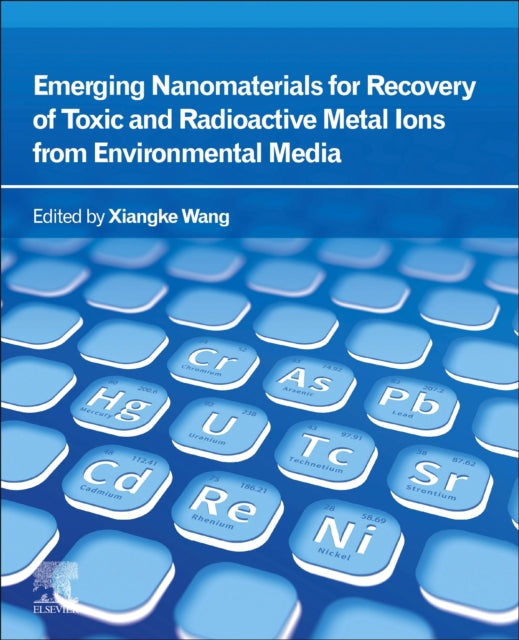Shulph Ink
Emerging Nanomaterials for Recovery of Toxic and Radioactive Metal Ions from Environmental Media
Emerging Nanomaterials for Recovery of Toxic and Radioactive Metal Ions from Environmental Media
YOU SAVE £57.13
- Condition: Brand new
- UK Delivery times: Usually arrives within 2 - 3 working days
- UK Shipping: Fee starts at £2.39. Subject to product weight & dimension
Bulk ordering. Want 15 or more copies? Get a personalised quote and bigger discounts. Learn more about bulk orders.
Couldn't load pickup availability
- More about Emerging Nanomaterials for Recovery of Toxic and Radioactive Metal Ions from Environmental Media
The book Emerging Nanomaterials for Recovery of Toxic and Radioactive Metal Ions from Environmental Media explores the use of nanomaterials in the remediation of contaminated sites by toxic or radioactive heavy metals. It covers various nanomaterials such as MOF-based, COF-based, MXene-based, nZVI-based, and carbon-based materials, and discusses their interaction mechanisms with metal ions through kinetic, thermodynamic, spectroscopic, and theoretical analyses. It serves as a valuable resource for academics, researchers, and advanced postgraduates in environmental sciences and environmental chemistry.
Format: Paperback / softback
Length: 394 pages
Publication date: 06 December 2021
Publisher: Elsevier - Health Sciences Division
Nanomaterials have emerged as powerful tools in the field of environmental remediation, specifically for the recovery of toxic and radioactive metal ions from environmental media. This comprehensive book delves into the diverse range of nanomaterials employed in the cleanup of contaminated sites, encompassing materials based on metal-organic frameworks (MOF), carbon-based materials (COF), MXene, nZVI, and carbon. By employing kinetic analysis, thermodynamic analysis, spectroscopic techniques, and theoretical calculations, the book provides a detailed exploration of the interactions between toxic/radioactive metal ions and these novel nanomaterials. It serves as a valuable resource for academics, researchers, and advanced postgraduates in the fields of environmental sciences and environmental chemistry, offering a thorough understanding of the applications and potential benefits of these innovative materials in the remediation of contaminated environments.
The utilization of nanomaterials in the environmental remediation of sites contaminated by toxic or radioactive heavy metals is the focus of Emerging Nanomaterials for Recovery of Toxic and Radioactive Metal Ions from Environmental Media. The book provides a comprehensive coverage of the use of various nanomaterials in remediation techniques, including metal-organic frameworks (MOF), carbon-based materials (COF), MXene, nZVI, and carbon. Through detailed kinetic analysis, thermodynamic analysis, spectroscopic techniques, and theoretical calculations, the book explores the primary interaction mechanisms between toxic/radioactive metal ions and these novel nanomaterials. It serves as a valuable reference for academics, researchers, and advanced postgraduates in the environmental sciences and environmental chemistry, offering a thorough understanding of the applications and potential benefits of these innovative materials in the remediation of contaminated environments.
The book comprehensively covers the use of MOF-based nanomaterials, COF-based nanomaterials, MXene-based nanomaterials, nZVI-based nanomaterials, and carbon-based nanomaterials in remediation techniques. It details the main interaction mechanisms between toxic/radioactive metal ions and the described novel nanomaterials through kinetic analysis, thermodynamic analysis, spectroscopic techniques, and theoretical calculations. The book provides a thorough reference on the use of the described novel nanomaterials for academics, researchers, and advanced postgraduates in the environmental sciences and environmental chemistry.
The book offers valuable insights into the development and application of nanomaterials in environmental remediation. It highlights the importance of understanding the physicochemical properties and chemical interactions of nanomaterials with toxic/radioactive metal ions to optimize their effectiveness in removing these pollutants from the environment. By exploring the use of MOF-based nanomaterials, COF-based nanomaterials, MXene-based nanomaterials, nZVI-based nanomaterials, and carbon-based nanomaterials, the book provides a comprehensive understanding of the potential of these materials in addressing the challenges posed by contaminated sites.
Furthermore, the book discusses the challenges and limitations associated with the use of nanomaterials in environmental remediation. It addresses issues such as the potential for nanomaterials to accumulate in the environment, their potential toxicity to human health and ecosystems, and the need for sustainable and environmentally friendly remediation techniques. The book provides recommendations for future research and development in the field of nanomaterials for environmental remediation, including the exploration of new nanomaterials, the development of more efficient remediation techniques, and the integration of nanomaterials with other environmental technologies.
In conclusion, Emerging Nanomaterials for Recovery of Toxic and Radioactive Metal Ions from Environmental Media is a valuable resource for academics, researchers, and advanced postgraduates in the environmental sciences and environmental chemistry. It provides a comprehensive coverage of the use of various nanomaterials in remediation techniques, highlights the main interaction mechanisms between toxic/radioactive metal ions and novel nanomaterials, and offers a thorough reference on the applications and potential benefits of these innovative materials in the remediation of contaminated environments. The book also discusses the challenges and limitations associated with the use of nanomaterials in environmental remediation and provides recommendations for future research and development in this field.
Weight: 816g
Dimension: 191 x 234 x 26 (mm)
ISBN-13: 9780323854849
This item can be found in:
UK and International shipping information
UK and International shipping information
UK Delivery and returns information:
- Delivery within 2 - 3 days when ordering in the UK.
- Shipping fee for UK customers from £2.39. Fully tracked shipping service available.
- Returns policy: Return within 30 days of receipt for full refund.
International deliveries:
Shulph Ink now ships to Australia, Belgium, Canada, France, Germany, Ireland, Italy, India, Luxembourg Saudi Arabia, Singapore, Spain, Netherlands, New Zealand, United Arab Emirates, United States of America.
- Delivery times: within 5 - 10 days for international orders.
- Shipping fee: charges vary for overseas orders. Only tracked services are available for most international orders. Some countries have untracked shipping options.
- Customs charges: If ordering to addresses outside the United Kingdom, you may or may not incur additional customs and duties fees during local delivery.


